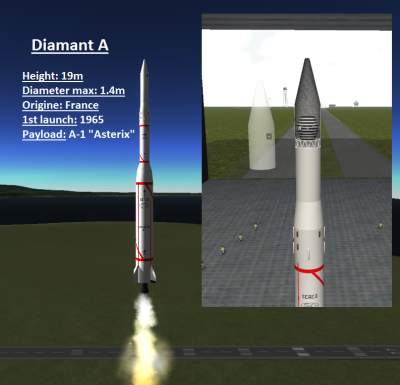In 1961, French President Charles de Gaulle created the National Center for Space Studies (CNES) as a "public administration with industrial and commercial purpose" under the French Ministries of Defence and Research. CNES was established to focus on five areas of interest: access to space, civil applications of space, sustainable development, science and technology research, security and defense. France was the third nation to achieve access to space after the U.S. and the U.S.S.R.
Work on the Diamant series of rockets began in 1962. The Diamant series was derived from French military rockets. It was the first French expendable satellite launch vehicle. It was also the first satellite launch vehicle not built by the U.S. or the U.S.S.R. The Diamant rockets have three stages. Hammaguir is a launch site in Algeria which was used by the French to launch sounding rockets and the first Diamant model rockets between 1947 and 1965. The Hammaguir launch facility was closed in 1967.
Between 1965 and 1975, nine of twelve Diamant launch attempts were successful. The Diamant had three different models. The first model was known as the Diamant A was sixty feet tall and weighted eighteen metric tons. It was used from 1965 to 1967 to launch four small satellites.
In 1965, France used a Diamant A to launch its first satellite called the Asterix which was the sixth satellite launched into Earth orbit by any nation. The Asterix weighted about ninety pounds. Its orbit was highly elliptical with a minimum altitude of three hundred miles and twenty five miles and a maximum altitude of one thousand fifty miles.
The second model, the Diamant B, had a more powerful first stage. From 1970 to 1973, the Diamant B successfully launched three satellites and failed in two other launch attempts. These missions were launched from the Guiana Space Center near Kourou in French Guiana in South America which was completed in 1969. The Diamant B was seventy seven feet tall and weighted twenty four metric tons.
The third model, the Diamant BP4 incorporated a new second stage. It was used to successfully launch four satellites in 1975. These launches also took place from the Guiana Space Center.
CNES partnered with other European countries on the Global Monitoring for Environment and Security initiative. This program launched a series of satellites to observe the land, oceans and the atmosphere. CNES, along with other European nations, is part of the Galileo navigation program. CNES has launched a number of satellites to support the French military. CNES is working with different nations on a wide variety of space projects including orbital telescopes, planetary probes, earthquake detection, water cycle observation, radiation analysis, soil moisture tracking and ocean salinity monitoring.
